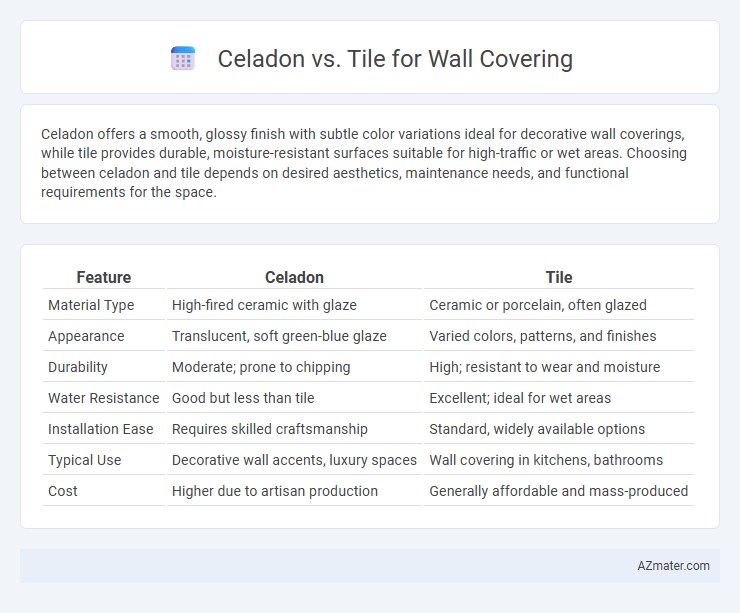Celadon offers a smooth, glossy finish with subtle color variations ideal for decorative wall coverings, while tile provides durable, moisture-resistant surfaces suitable for high-traffic or wet areas. Choosing between celadon and tile depends on desired aesthetics, maintenance needs, and functional requirements for the space.
Table of Comparison
| Feature | Celadon | Tile |
|---|---|---|
| Material Type | High-fired ceramic with glaze | Ceramic or porcelain, often glazed |
| Appearance | Translucent, soft green-blue glaze | Varied colors, patterns, and finishes |
| Durability | Moderate; prone to chipping | High; resistant to wear and moisture |
| Water Resistance | Good but less than tile | Excellent; ideal for wet areas |
| Installation Ease | Requires skilled craftsmanship | Standard, widely available options |
| Typical Use | Decorative wall accents, luxury spaces | Wall covering in kitchens, bathrooms |
| Cost | Higher due to artisan production | Generally affordable and mass-produced |
Introduction to Wall Covering Options
Celadon and tile represent distinct wall covering options offering unique aesthetic and functional benefits. Celadon, a ceramic glaze with a translucent, pale green hue, introduces a soft, elegant texture popular in Asian-inspired interiors. Tiles, available in materials like ceramic, porcelain, and natural stone, provide versatile, durable surfaces that suit both decorative and practical wall applications in kitchens, bathrooms, and commercial spaces.
What is Celadon?
Celadon is a type of ceramic glaze known for its distinctive pale green to blue-green color, originating from ancient Chinese pottery traditions. Unlike traditional tiles, celadon surfaces are smooth and glass-like, offering a subtle sheen that adds elegance to wall coverings. Its unique translucent quality and soothing hues make celadon a popular choice for creating serene and sophisticated interior designs.
What are Ceramic and Porcelain Tiles?
Ceramic and porcelain tiles are popular materials used for wall coverings, distinguished mainly by their manufacturing process and water absorption rates. Ceramic tiles are made from red or white clay and fired at lower temperatures, making them more porous and often glazed for added protection. Porcelain tiles, a subtype of ceramic, are fired at higher temperatures, resulting in a denser, harder tile with lower water absorption, ideal for areas exposed to moisture.
Aesthetic Differences: Celadon vs Tile
Celadon wall coverings present a soft, translucent glaze with subtle, muted tones that evoke a calming, antique aesthetic characterized by nature-inspired motifs and smooth textures. Tiles offer a broader spectrum of finishes, including glossy, matte, and textured surfaces, enabling bold geometric patterns and vibrant colors that suit contemporary and eclectic design schemes. The choice between celadon and tile hinges on desired visual impact: celadon enhances spaces with understated elegance and historical charm, while tiles provide versatile options for dynamic, modern wall accents.
Durability and Longevity Comparison
Celadon, a traditional glazed ceramic, offers moderate durability suitable for low-traffic wall areas but may be prone to chipping under impact due to its delicate glaze. Tile, particularly porcelain or ceramic variants, provides superior durability and longevity with resistance to moisture, scratches, and heavy wear, making it ideal for both residential and commercial wall coverings. Proper installation and maintenance further enhance tile's lifespan, often exceeding several decades without significant deterioration.
Maintenance and Cleaning Requirements
Celadon wall coverings typically require gentle cleaning methods using a soft cloth and mild detergent to maintain their smooth, ceramic-like surface, avoiding abrasive cleaners that can damage the finish. Tile wall coverings, especially glazed ceramic or porcelain tiles, offer superior durability and ease of maintenance, allowing for regular wiping and scrubbing with standard household cleaners without compromising their integrity. Grout lines in tiled walls necessitate periodic sealing and cleaning with specialized grout cleaners to prevent staining and mold growth, unlike Celadon finishes that usually do not have grout lines.
Cost Analysis: Celadon vs Tile
Celadon wall coverings typically incur higher initial costs due to their handcrafted nature and unique glaze techniques, making them a premium choice compared to standard ceramic or porcelain tiles. Tile options generally offer a more cost-effective solution with a wide range of prices, influenced by material type, design complexity, and installation methods. Long-term maintenance for celadon is often minimal but requires careful handling, while tiles can vary in durability and upkeep depending on their quality and surface finish.
Installation Process and Considerations
Celadon wall coverings typically require a meticulous installation process involving careful alignment and smoothing due to their delicate texture, often needing professional expertise to prevent damage. Tile installation demands thorough surface preparation, precise measurement, and grouting, with options such as ceramic or porcelain tiles offering durability but requiring specialized tools and skills. Both materials necessitate consideration of wall conditions, moisture levels, and adhesive compatibility to ensure long-lasting adhesion and aesthetic appeal.
Best Applications: Where to Use Celadon or Tile
Celadon, a glazed ceramic with a subtle greenish hue, is ideal for bathroom walls and kitchen backsplashes due to its moisture resistance and elegant aesthetic. Tile, available in various materials such as porcelain, ceramic, and natural stone, offers greater durability and versatility, making it suitable for high-traffic areas like entryways and feature walls. Choosing Celadon enhances spaces requiring a serene, refined look, while tile provides practicality and design flexibility for both residential and commercial wall coverings.
Environmental Impact and Sustainability Factors
Celadon ceramic tiles are typically made from natural clay and minerals, offering a renewable material source with lower embodied energy compared to synthetic tile options, reducing environmental impact. Tile wall coverings often involve energy-intensive manufacturing processes and non-biodegradable components, potentially increasing carbon emissions and landfill waste. Choosing Celadon tiles supports sustainable design through biodegradable attributes, local sourcing, and longer lifespan, minimizing environmental footprint in wall covering applications.

Infographic: Celadon vs Tile for Wall Covering
 azmater.com
azmater.com